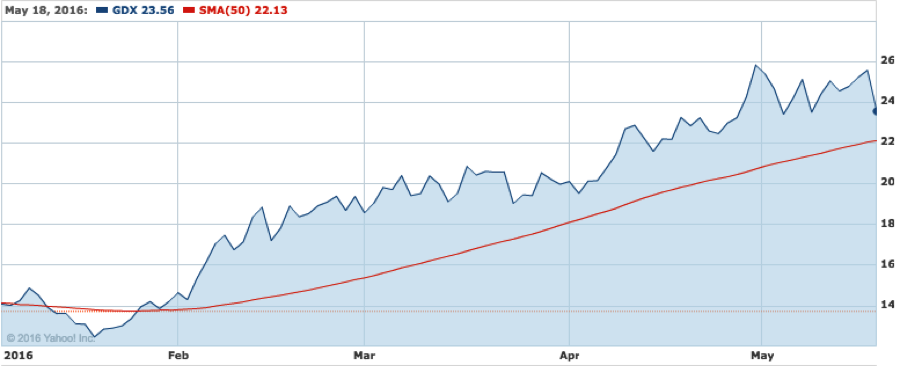
The Maven Letter: May 25, 2016
Maven Mondays…on Tuesday

Apologies for missing last Monday’s note. In the wake of the very successful Metals Investor Forum May 14 & 15 in Vancouver, I needed a day off. It was also my birthday so my spouse – having not seen me for days leading up to the Forum! – banned me from working so we could spend some time together. I happily agreed.
Ah gold. Today’s US housing numbers strengthen the case for a rate hike in June. New home sales posted their strongest month in eight years, up 16.6% month over month, even while prices climbed to a record level.
How much does it matter? Tough to say. Very low mortgage rates are certainly encouraging families to enter the housing market, something they would not likely do without stable employment and good wages. On the flip side, newly built homes make up just 10% of all home purchases and the data is often revised significantly. And the market, while improving, remains below pre-recession levels with respect to construction and sales. As for employment and wages…that’s a debate for another day.
Gold certainly dropped on the news, while the US dollar and US stocks jumped. It all fits with the broad pattern I have been predicting for this month, which I outline in today’s article, taken from last week’s Maven Letter.
As always, if you enjoy these snippets consider a free trial subscription to the Maven Letter, my weekly newsletter on what I am buying, selling, and thinking in terms of metals and mining.
On The Macro: Rotation, Recession or Not
Everyone in the mining sector, literally everyone, is worried about a correction.
Fair enough. After five long and dark years, the last thing any of us are is overconfident. So when we look at this year’s sharp gains in gold and miners, instead of being happy we just feel anxious about what will happen next.
There are a couple points that pertain here.
- The biggest force driving gold has been US investors rotating into the sector in search of security and value. The end of the US bull market plus low interest rates, a topped-out US dollar, and droves of political and economic uncertainty are driving this rotation. These gold investors will not, in general, sell after a short time – they were pushed here by systemic plagues and those plagues remain far from healed.
- Negative real interest rates encourage investors to buy gold. Yes, if the US does raise rates in mid-June America will not be in a negative rate situation – but much of the rest of the world still is and all those investors will buoy gold. US investors, seeing high equity valuations, a range-bound dollar, and still-low rates, will join in if gold goes whether their real rates are slightly positive or not.
- Momentum in gold and miners feeds itself. Investors leave the sector when things turn down, but they return when prices come back to life because they have played this game before. That memory – of the gains that a mining bull market can create – attracts so much interest that momentum in gold feeds itself: the desire to play creates such a depth of demand that pullbacks get muted by investors piling into each buying opportunity.
- Many of the explorers and developers that stayed alive through the bear market have already taken advantage of the improved markets, raised money, and gotten back to work. The result will be a summer like we haven’t seen for a while: full of news. Exploration successes, takeover deals, development decisions, and new discoveries are the fuel that drives a mining revival – each announcement attracts investment interest, in the stocks announcing the news and in those the market thinks might announce something next.
Gold already started correcting following the Fed’s fear-provoking announcement that it might raise rates in mid-June. This was not actually a surprise, as the decision still remains dependent on data (which has been the stance all along), but the market had convinced itself a raise was essentially off the table.
The suggestion that a raise was possible sent gold down 2% and lifted the US dollar 0.8% in short order.
Sounds dramatic. And it is, to those of us acutely tuned to gold’s gyrations. But (as I keep saying), try to keep it in context.
 Gold’s correction is minor so far. Gold miners corrected more, but the change is still within trend:
Gold’s correction is minor so far. Gold miners corrected more, but the change is still within trend:
 Is there more downside ahead? Likely yes. Gold is seasonally weak in June, precisely because there is always a Federal Reserve meeting. This year’s meeting carries more weight than most. Now that the Fed has re-affirmed its commitment to raising rates as long as Q2 data points to stronger growth, inflation, and employment, the markets are starting to price in the real potential for a raise.
Is there more downside ahead? Likely yes. Gold is seasonally weak in June, precisely because there is always a Federal Reserve meeting. This year’s meeting carries more weight than most. Now that the Fed has re-affirmed its commitment to raising rates as long as Q2 data points to stronger growth, inflation, and employment, the markets are starting to price in the real potential for a raise.
That will weigh on gold until June 15. How much? Hard to say, but I would be surprised if gold went below its mid-February low of US$1,205 per oz. That gives the market $50 worth of gold price room to play with.
A fall back near US$1,200 would create anxiety among mining folks, but it would actually only represent a 7% correction from the May 3 peak of US$1,294 per oz. and only 4% from current levels. Given that gold gained as much as 20% to start the year, a 7% correction would just be part of the process.
Miners might give up more. As you can see from the charts above, gold gained only moderately from mid-February until now, adding just 2.5%. Miners, on the other hand, just kept on climbing, adding 31% in the same time frame.
That’s leverage for you! While everyone loves leverage to the upside, remember that leverage bites both ways. If gold spends the next few weeks correcting a couple percent, I would expect the GDX to lose multiples more. Stock specifics matters with miners, but when gold falls they all fall with it.
How explorers and developers react will vary more. Explorers with good momentum can override a commodity price correction (or even a commodity price that has lagged for years – look at NexGen Energy’s success despite the uranium price). Developers and new producers can too, because the investment story there is bigger picture: these companies are positioning to profit, either on their own or through a takeover, in the coming bull market. That story remains intact if gold corrects for a few weeks, at least among all the investors who see brighter days beyond.
I still do not know what Janet Yellen and team will do on June 15. They want to raise rates, so if data between now and then shows GDP growth improvement, suggests inflation, and maintains the Fed-painted picture of a healthy employment scene, raise they will.
Given how obsessed the markets are with Janet Yellen, the lead-up to June 15 might be more significant than the event itself. If data suggests support for a hike, the market will price it in and then some. If data are mixed, bets will be too and the reaction will play out with the announcement.
Either way, this is all happening within a setting that is not going to change dramatically in the space of a few weeks – and to me that setting says gold is set to go.
Here’s the thing. I could go, again, into my argument for why the US economy is slowing, instead of speeding up. I could argue that market valuations are stretched, earnings are declining, inventory-to-sales ratios are up, and bankruptcies are rising.
Instead, I want to present the other side of the argument. How does the argument against a US market downturn go? And what would that mean for gold?
The most logical such line of reasoning I have encountered of late came from an article by Urban Carmel of the Fat Pitch Blog, available here. It is worth a read.
Carmel points out that earnings and sales growth have been declining since the third quarter of 2014. Coincident, the S&P has produced very little net gain since then.
 The question then becomes: do weak or declining sales and earnings numbers suggest a recession is ahead?
The question then becomes: do weak or declining sales and earnings numbers suggest a recession is ahead?
His conclusion is No. Rather than systemic economic weakness, he says two factors explain declining earnings and sales: a 75% drop in the price of energy and a 20% gain in the dollar.
Energy is struggling, of course. Sales have fallen by more than half since late 2014. Carmel suggests, though, that sales are not fallen in other sectors. Healthcare and discretionary spending are up, while most other sectors are simply flat.
That begs the question: what are sales flat? US demand growth has averaged 3 to 5% year-over-year for several years. That should create sales growth. Should – except that companies in the S&P derive about half their sales from outside the US, mostly from Asia and Europe. Of course, growth in those parts of the world is considerably weaker (1 to 1.5%).
That’s one explanation for flat sales. The other: the strength of the dollar. As the dollar rises, the value of sales earned abroad falls. Carmel calculates that, assuming half of the sales of the S&P come from outside the US, the dollar’s rise on its own has cut S&P sales by 10%.
So rather than systemic economic weakness, we have a market struggling under a strong dollar and an energy price rout.
If so, what’s next?
Oil cannot decline to the same extent this year that is did last, as that would take the price to $20 a barrel.
Instead a partial recovery is more likely, as has been the pattern following most significant oil price drops.
For the dollar, a similar argument: it would be very difficult for the greenback to continue rising, so sideways is a safe assumption.
Should those forecasts hold – sideways for both oil and the dollar – the result is continued flat sales across the S&P. Carmel suggests that is not sufficient reason for the markets to decline.
This is where I diverge in my reasoning.
Markets will maintain stretched valuations for a time – but not forever. After six years of gains, sideways feels like losing ground. Used to ever-ascending share prices, investors are not content with their investments treading water.
To me, that discontent is why US stock funds have now posted outflows in 15 of 19 weeks and why investors are pulling money from equity funds at the fastest pace since 2011. Redemptions have reached nearly $90 billion so far this year, according to the Financial Times.
At the end of the day, whether the economy treads water or slides into a recession doesn’t matter – in either case, stocks are expensive and a lack of continued gains will disappoint investors, who are already looking elsewhere for upside.
On top of that, there is immense uncertainty over what the markets will do. Investors are increasingly aware that the markets could turn down significantly and continued sideways action feeds that concern. If momentum starts to shift away from the market because of uncertainty, sideways could easily become down.
Gold offers panacea to both concerns: as a safe haven it offers security and as one of few sectors to have missed the bull market it offers value.
So there: even when I diverge from my regular reasoning, I come to the same golden conclusion!
As for the near term, expect gold to be volatile within its current trading range for the next two to four weeks. If you agree that all paths lead to better gold prices in the future, use down days to establish or add to positions in gold equities.



